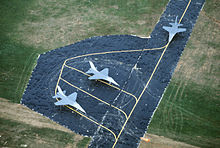- Military dummy
-
A dummy round is a round of ammunition that is completely inert, i.e., contains no primer, propellant, or explosive charge. It is used to check weapon function, and for crew training[1]. Dummy ammunition is distinct from "practice" ammunition, which may contain smaller than normal amounts of propellant and/or explosive.[2] For example, the M69 practice hand grenade[3] emits a loud pop and a puff of white smoke.
A dummy is not to be confused with a blank, a cartridge for a firearm that contains propellant but no bullet or shot: a dummy does not produce an explosive sound like a blank does.
Dummies and decoys for deception
 Inflatable S-300 missile system
Inflatable S-300 missile system
Dummies and decoys are fake military equipment that are intended to deceive the enemy. During World War II, multiple dummy airfields and even towns were used in England to divert German bombers from the real targets[4]. At the Battle of La Ciotat in 1944, American aircraft dropped hundreds of dummy paratoopers (Paradummies) just north of La Ciotat, France. The goal of this operation was to divert German troops away from the main landing zones of Operation Dragoon. Additionally, during World War II, Operation Quicksilver was an attempt to mislead the Germans as to the location of the D-Day invasion using dummy military equipment. [5]
A naval example was the British battleship HMS Centurion. Obsolete and disarmed by World War II, she spent two years in the Mediterannean fitted with wooden guns, to make British naval forces in the area seem stronger than they were. Likewise, Fleet tender was the codename for a number of British merchant ships that fitted with dummy structures to resemble warships.
F-16 mockups on a fake runway at Spangdahlem Air Base, 1985.
An intercontinental ballistic missile may release decoys in addition to one or more warheads.
Dummies and decoys are only one aspect of military deception.
See also
References

This military-related article is a stub. You can help Wikipedia by expanding it.

